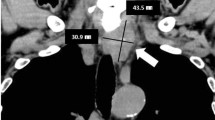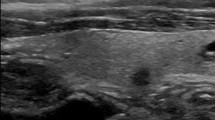Abstract
Background
To assist surgeons in identifying and preserving the parathyroid gland (PTG) in endoscopic thyroidectomy (ET), we have summarized the characteristics of the PTG and the surrounding tissues in ET by applying the Storz Professional Image Enhancement System (SPIES).
Methods
From November 2014 to May 2016, 182 patients with 613 suspected PTGs were included in our study. The shape, color, area, and density of surface blood vessels (SBVs); whether they were encapsulated with adipose tissue; and whether congestion was present during the operation were summarized. The κ coefficient of interobserver agreement in assessing the area and the density of SBVs of suspected PTGs with and without Spectra A (SA) and Spectra B (SB) modalities were calculated. Multiple binary logistic regression analyses were performed to determine the predictive value of different characteristics for detecting the PTG in ET with the application of SPIES.
Results
With visual identification and histopathological results as reference standards, 291 targeted tissues were identified as PTGs, 256 as adipose tissue, 43 as lymph nodes, and 23 as thyroid tissue. The κ coefficients of interobserver agreement in assessing SBV density with or without the SA and SB modalities were 0.944 ± 0.013 and 0.859 ± 0.021, respectively, and those in assessing SBV area were 0.937 ± 0.014 and 0.841 ± 0.022, respectively. In the comparison between PTGs and other tissues, multiple binary logistic regression analysis revealed that shape, color, SBV density, congestion, and whether tissue was encapsulated with adipose tissue were independent predictive factors of PTGs.
Conclusion
With the application of SPIES, the shape, color, density of SBVs, adipose tissue encapsulation, and congestion were independent factors that predicted PTGs in ET. The SA and SB modalities of SPIES could improve the reliability of SBV density and area classifications in targeted tissues.






Similar content being viewed by others
References
Fancy T, Gallagher D 3rd, Hornig JD (2010) Surgical anatomy of the thyroid and parathyroid glands. Otolaryngol Clin North Am 43:221–227
Alveryd A (1968) Parathyroid glands in thyroid surgery. I. Anatomy of parathyroid glands. II. Postoperative hypoparathyroidism—identification and autotransplantation of parathyroid glands. Acta Chirurg Scand 389:1–120
Fateev IN (1999) Current problems in the surgical anatomy of the thyroid and parathyroid glands. Morfologiia 116:78–81
Darr EA, Randolph GW (2013) Management of laryngeal nerves and parathyroid glands at thyroidectomy. Oral Oncol 49:665–670
Lorente-Poch L, Sancho JJ, Ruiz S, Sitges-Serra A (2015) Importance of in situ preservation of parathyroid glands during total thyroidectomy. Br J Surg 102:359–367
Rajinikanth J, Paul MJ, Abraham DT, Ben Selvan CK, Nair A (2009) Surgical audit of inadvertent parathyroidectomy during total thyroidectomy: incidence, risk factors, and outcome. Medsc J Med 11:29
Jian R, Gong Z, Zhu ZC, Zhou C, Si-An HU (2011) Identification and protection of parathyroid glands in video-assisted endoscopic thyroid surgery. Chin J Laparosc Surg 4:261–264
Williams SP, Wilkie MD, Tahery J (2014) Microscope-assisted thyroidectomy: our experience in one hundred and twenty-one consecutive cases. Clin Otolaryngol 39:307–311
Almquist M, Hallgrimsson P, Nordenstrom E, Bergenfelz A (2014) Prediction of permanent hypoparathyroidism after total thyroidectomy. World J Surg 38:2613–2620
Ling HHYHR. (2011) Preservation of parathyroid gland during the resection of thyroid neoplasms: anatomy and operative procedure. Chin J Clin Anat 29:461–460
Long M, Luo D, Diao F, Huang M, Huang K, Peng X, Lin S, Li H (2017) A Carbon nanoparticle lymphatic tracer protected parathyroid glands during radical thyroidectomy for papillary thyroid non-microcarcinoma. Surg Innov 24:29–34
McWade MA, Paras C, White LM, Phay JE, Mahadevan-Jansen A, Broome JT (2013) A novel optical approach to intraoperative detection of parathyroid glands. Surgery 154:1371–1377 (discussion 1377)
Kamphuis GM, de Bruin DM (2016) Storz professional image enhancement system: a new technique to improve endoscopic bladder imaging. J Cancer Sci Ther 08:71–77
Sid-Ahmed MA (1995) Image processing, theory, algorithms and architectures. McGraw-Hill Inc., New York
Huang XM, Sun W, Zeng L, Liu X, Lu X, Xu YD, Zhang ZG, Xu G (2011) Gasless endoscopic thyroidectomy via an anterior chest approach: a review of 219 cases with benign tumor. World J Surg 35:1281–1286
Lang BH, Wong KP (2013) A comparison of surgical morbidity and scar appearance between gasless, transaxillary endoscopic thyroidectomy (GTET) and minimally invasive video-assisted thyroidectomy (VAT). Ann Surg Oncol 20:646–652
Hakim Darail NA, Lee SH, Kang SW, Jeong JJ, Nam KH, Chung WY (2014) Gasless transaxillary endoscopic thyroidectomy: a decade on. Surg Laparosc Endosc Percutan Tech 24:e211–e215
Tae K, Ji YB, Cho SH, Kim KR, Kim DW, Kim DS (2011) Initial experience with a gasless unilateral axillo-breast or axillary approach endoscopic thyroidectomy for papillary thyroid microcarcinoma: comparison with conventional open thyroidectomy. Surg Laparosc Endosc Percutan Tech 21:162–169
Acknowledgements
This study was supported by a research grant from the Sun Yat-Sen University Clinical Research 5010 Program (Grant 2010008).
Author information
Authors and Affiliations
Corresponding author
Ethics declarations
Disclosures
Peiliang Lin, Ping Han, Faya Liang, Qian Cai, Renhui Chen, Shitong Yu, and Xiaoming Huang have no conflict of interest or financial ties to disclose.
Additional information
Peiliang Lin and Ping Han have contributed equally to this work.
Rights and permissions
About this article
Cite this article
Lin, P., Han, P., Liang, F. et al. Characteristics of the parathyroid gland in endoscopic thyroidectomy with the application of an image enhancement system. Surg Endosc 32, 3925–3935 (2018). https://doi.org/10.1007/s00464-018-6132-1
Received:
Accepted:
Published:
Issue Date:
DOI: https://doi.org/10.1007/s00464-018-6132-1




